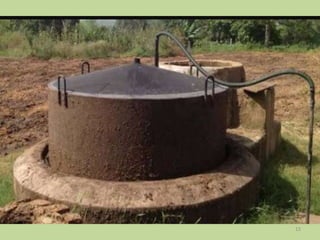Biogas
- 1. welcome 1
- 2. Biogas 2 Biogas typically refers to a mixture of gases produced by the natural anaerobic digestion of organic matter in the presence of moisture. Renewable energy source.
- 3. Indian scenario • India has installed 4.75 million small scale biogas plants. • India have additionally commissioned 158 projects under its biogas based grid power generation programme, with a total installed capacity of 2 MW. • To support above programme the government providing 50% subsidy for installation of biogas plant. 3
- 4. 4
- 5. Raw materials 5 Animal dung Poultry wastes Crop residue Sewage Industrial wastes Domestic wastes
- 6. 6
- 7. TYPICAL GAS PRODUCTION FROM DIFFERENT FEEDSTOCK 7
- 8. Anaerobic digestion Treatment of any slurry/sludge containing organic matter utilizing micro-organisms under anaerobic condition . Stages of digestion The enzymatic hydrolysis Acid formation Methane formation 8
- 9. 9
- 10. Estimation for sizing 1kg of dry cattle dung produces approximately 1m3 of bio gas. 1 kg of fresh cattle dung contains 8% dry bio degradable mass 1kg of fresh cattle dung has a volume of about 0.9 L 10
- 11. Factors Dynamic equilibrium between acid formers and methane fermenters Temperature : 8-55oC pH : 6.8-7.8 C:N Ratio : 25:1-30:1 Water content 90% and solid organic matter 8-9% 11
- 12. Types of biogas plants 12 Floating dome type KVIC type Fixed dome type Deenbandhu biogas plant, janata type.
- 13. 1. Floating dome type Mixing tank -mixture of dung and water(4:5) Inlet Digester -fermentation Floating drum -collection of gas Outlet -fermented material flow out 13
- 14. 14
- 15. 15
- 16. Gas holder : Drum –Cylindrical and concave in shape Mild steel sheet Top - Supported radically Angular iron Gas pressure : 7-9cm of water column Cost : Rs. 14,000 for 2m3 16
- 17. Fixed dome type Mixing tank Inlet Digester Outlet 17
- 18. 18
- 19. Gasholder :Hemispirically fixed dome Reinforced concrete Cost : Rs. 8,000 for 2m3 19
- 20. 20
- 21. 21
- 22. Advantages of biogas as a fuel 22 High calorific value Clean fuel No residue produced No smoke produced Non polluting Economical Burns readily
- 23. Uses and application of biogas 23 Domestic fuel For street lighting Generation of electricity If compressed, it can replace compressed natural gas for use in vehicles
- 24. 24 A biogas bus, Sweden The bio gas train Amanda, Sweden
- 25. One cubic metre of bio gas can do the following operations: It can illuminate a mantle lamp (60 W) for a period of 7 hours . It can run 2 hp engine for one hour . It can be used for cooking three meals for a family of five . It can run 100L capacity refrigerator for 9hours . It can generate electricity of 1.25 KWH. Family biogas plant - 2-3 m3. 25
- 26. Advantages : 26 Low initial investment Suitable for rural areas . Reduce the dependence of non renewable resources. The by products , nitrogen rich manure can be used. It improves sanitary condition and checks environmental pollution .
- 27. Limitations : 27 Initial cost of installation of the plant is high. Number of cattle owned by an average family of farmers is inadequate to feed a biogas plant.
- 28. Conclusion 28 Biogas is a clean renewable source of energy. The research organizations should focus on newer efficient low cost designs. The government can play important role by introducing different education schemes and the availability of technology and providing more subsidies.
- 29. Biogas technology – B T Nijaguna ANGRAU Notes Internet sources 29
- 30. 30 Thank Yo





























